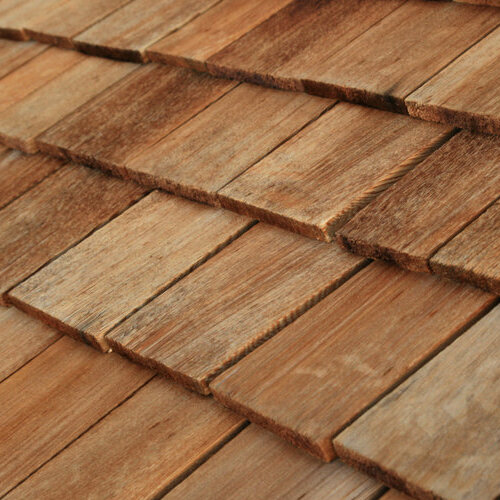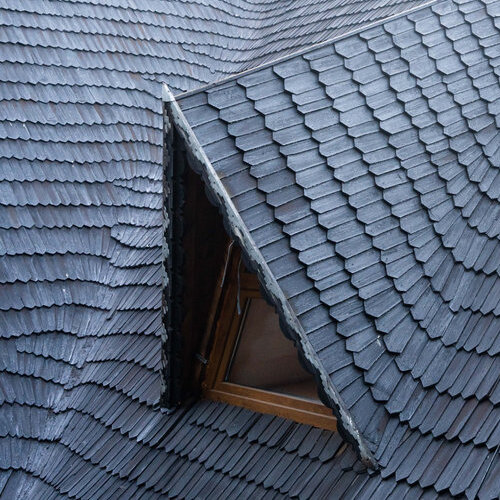
A Range of Roofing Materials
There are many types of roofing materials, from asphalt shingles to ceramic tiles, and metal roofing to cedar shake roofing. Each type of roofing includes many different types within them, like wood roofing materials.
Within the category of wood roofing, there is wood shake roofing and wood shingle roofing, and that it what we’re going to discuss today. Let’s start by defining: what is a wood shake roof? Wood cedar shake roofing, the more popular wood choice, is made of a wood roofing material that is produced by a wooden log being split into thin rectangles. Typically one side is sawn, and the other side is hand split, making a thicker wood roofing material than often found with wood shingles.
Where the main difference between wood shake vs wood shingle is defined in the manufacturing, it should also be noted that wood shingles are made from a log of wood, but both sides are sawn, making them thinner at the butt end compared to standard wood cedar shake roofing material. Both wood shingles and wood shakes are a wedge shape and are individually affixed to the roofing deck.
How long do cedar shake roofs last?
A basic new roof is an investment, but when you go with a cedar shake roofing, the investment is higher, and a homeowner will expect to get as long of lifespan as possible. Ideally, a homeowner hopes to only have to go through a new roof expense once, or perhaps twice at the most.
As long as a cedar shake roofing is installed correctly by the roofing contractor, and the homeowner keeps proper maintenance and upkeep, 30 years is the average life span. Depending on the quality of the materials used and factors such as the climate and environment conditions, some cedar shake roofing has been known to last 50 years.
Because the shake for wood cedar shake roofing materials is naturally made, there isn’t a manufacturer warranty. That’s why you’ll want to find a roofing contractor that is experienced in cedar shake roofing installation and who offers a warranty on their work. It is that warranty that will be your best chance that the workmanship is of a quality level.
What is the life expectancy of a wood shake roof?
The most common wood shake roof material in the United States is western red cedar shake roofing. It is available in abundance and has proven to be the most weather-resistant of all wood shake roofing. The other species of wood that are used, but not as commonly, are:
- California redwood
- Cypress
- Atlantic white cedar
Like cedar shake roofing, other types of wood are natural, so you’re depending more on the quality of the installation than the wood itself for lifespan. The average can be between 20 years and 40 years with expert installation and proper wood shake care by the homeowner.
Are wood shake roofs safe?
Wood is a natural material, making it a flammable material and a fire hazard. However, it should be noted a fire retardant chemical is usually applied to cedar shake roofing and other types of wood roofing. The fire retardant chemical treatment on a cedar shake roofing or any type of wood roofing needs to be re-applied every 3 to 5 years by a professional.
How do you repair a cedar shake roof?
A cedar shake roofing isn’t going to be any different than other types of wood roofing. When wet, it will swell, and when the weather is dry, it will contract. After years of swelling and contracting, even with preservation treatment it will still do this from time to time, and the cedar shakes weaken and the felt lining that is installed below them will deteriorate.
The deteriorated felt, referred to as underlayment, is less resistant to leaking at that point, and with cracked, cupped, missing, and worn cedar shake roofing materials, the roof becomes susceptible to leaking altogether.
Since OSB or plywood decking isn’t a water-tight barrier on its own, that leaking roof will begin showing on the ceiling inside your home. By then, it has come to the point that a professional repair is recommended. However, as a DIY homeowner, if you choose to try this yourself, the following steps will get you through the process.
Find the Source
As with the type of roofing, finding the source of the leak is a must. You need to start inside the attic during the day. With a flashlight in hand but turned off, inspect the roof from the underside for a pinhole of daylight. With the flashlight on, look for moisture or water stains on the roof’s underside or on the rafters. Because water flows or rolls downhill, follow the water stain to find the highest point, you’ll find the leak source there.
Mark the area, measuring from the closest outside wall so you have an idea where it is when you get on the roof. Now, take the next step toward repairing your cedar shake roofing leak.
Up On the Rooftop
With safety gear on and an extension ladder firmly planted on the ground, take the measurement you have from inside the attic and add the measurement of the overhang This should get you at or close to the leak source and you can begin the actual repairing of your cedar shake roofing. Now follow these steps to make your cedar shake roof leak repair:
Place a flat wooden block just below the area of the cedar shake roofing to be repaired. This will protect the lower shakes from damage. With a 16-inch pry bar, pry the lower edge of a cedar shake to the side of the leaking area. With pressure against the block you installed, cut the roofing nails under the shake, then repeat this process on the other side of the leak.
While wearing work gloves, with pliers, fold the opposite corners of a piece of sheet metal. Crimp each corner securely so they won’t catch under the shake and slide under both shakes you cut the nails under. Make sure it is completely over the leak and the lower edge of the metal is even with the lower edges of the shakes.
Using five-penny cedar wood roofing nails and a hammer secure the shakes and metal shingle evenly spaced. The nails should be installed between the outer edges of the shingles’ exposed portions.
Testing Your Work
With your equipment and materials collected, and safe on the ground, it is time to test your cedar shake roofing repair. Climb up the ladder and have somebody hold the garden hose as you spray over the area you repaired. Have a spotter inside the attic and house to watch for leaks. If you don’t see any water after 10 minutes, then your repair is done. If there is any leaking, this can often be patched with roofing caulk, usually around the nails.

Topping Off Your Repair
What are the wood shake benefits that make them worth having? Cedar shake roofing is one of the oldest roofing materials and one of the most reliable. However, it isn’t as easily available as it once was, and that has made it more expensive.
The architectural appeal it gives a home is the biggest attraction and benefit. The natural color and rich dimensions along with the unique texture give any home a curb appeal that is beyond stunning. If you’re ready to learn more about wood shakes and cedar shake roofing, reach out to us at 865-238-2628.